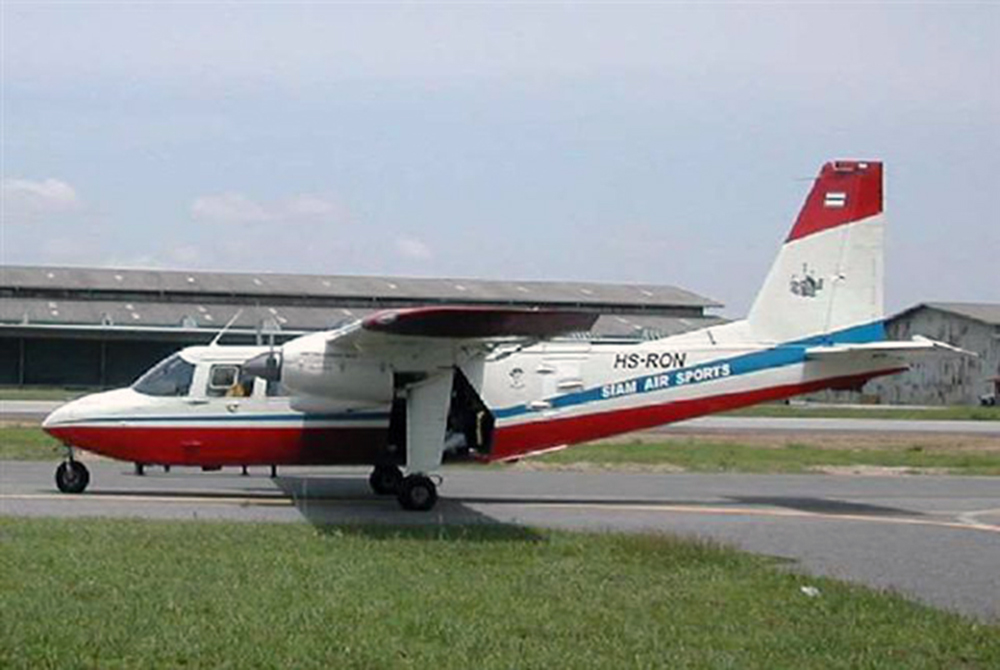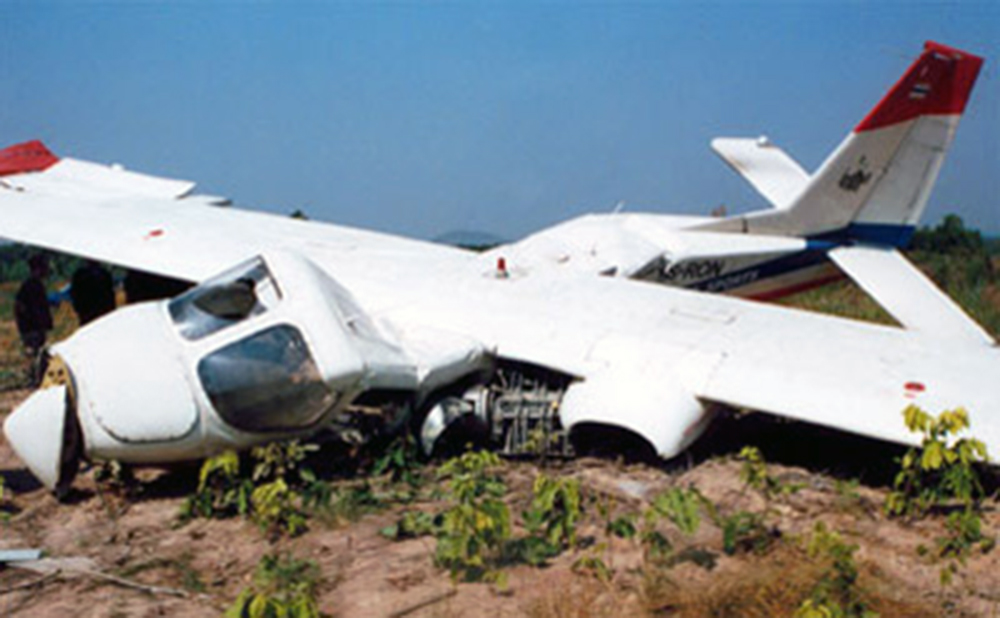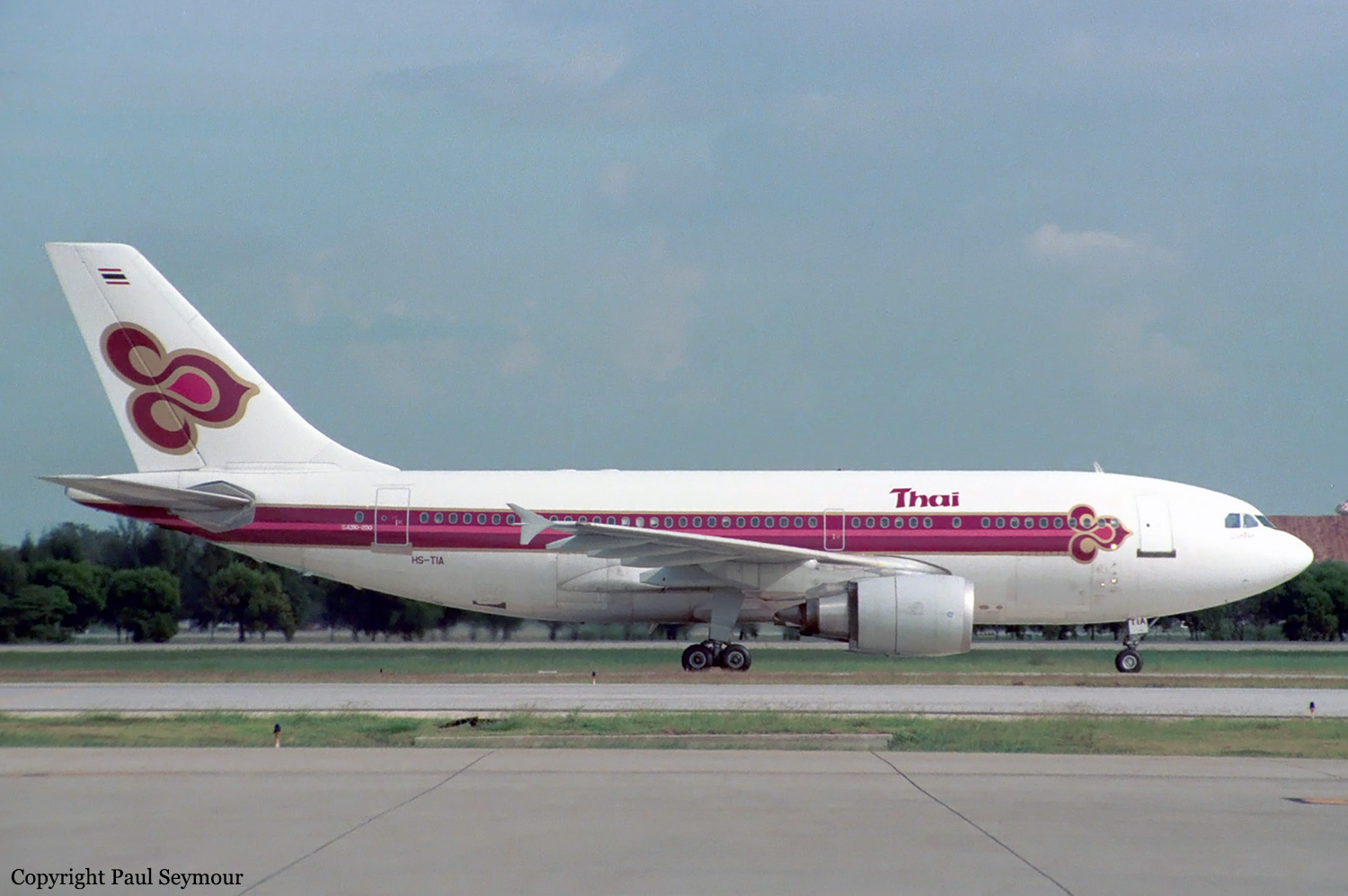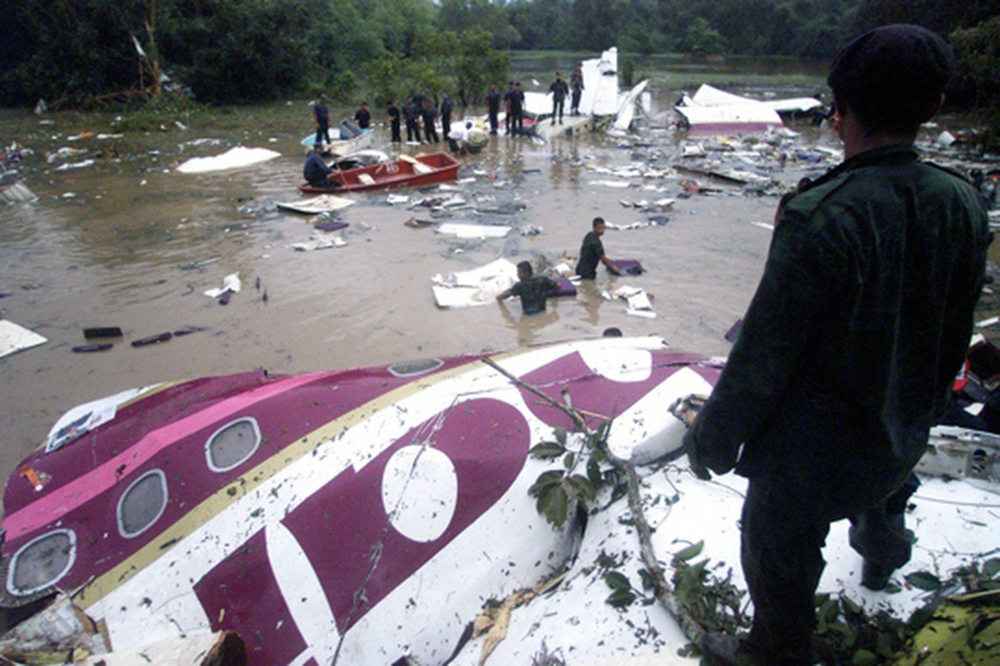Region
Crash of an Avro 748-208-2A in Bangkok
Date & Time:
Nov 22, 2004
Registration:
99-999
Survivors:
Yes
MSN:
1715
YOM:
1972
Crew on board:
0
Crew fatalities:
Pax on board:
0
Pax fatalities:
Other fatalities:
Total fatalities:
0
Circumstances:
Upon landing, the nose gear collapsed. The aircraft slid for few dozen metres before coming to rest. All occupants escaped uninjured while the aircraft was damaged beyond repair.
Probable cause:
Failure of the nose gear on landing for unknown reasons.
Crash of a Piper PA-46-350P Malibu Mirage near Lop Buri: 3 killed
Date & Time:
Apr 26, 2003 at 1430 LT
Registration:
HS-AKS
Survivors:
No
Schedule:
Bangkok – Chiang Mai
Crew on board:
1
Crew fatalities:
Pax on board:
2
Pax fatalities:
Other fatalities:
Total fatalities:
3
Circumstances:
The single engine aircraft departed Bangkok-Don Mueang on a private flight to Chiang Mai with two passengers and one pilot on board. During climbout in marginal weather conditions, the pilot was cleared to climb to 11,000 feet when control was lost. The aircraft crashed in a cornfield located near Lop Buri. All three occupants were killed. There was some thunderstorm activity in the area at the time of the accident.
Crash of a Britten-Norman BN-2A-26 Islander in Pattaya
Date & Time:
Jan 14, 2003 at 1300 LT
Registration:
HS-RON
Survivors:
Yes
Schedule:
Pattaya - Pattaya
MSN:
156
YOM:
1970
Crew on board:
1
Crew fatalities:
Pax on board:
6
Pax fatalities:
Other fatalities:
Total fatalities:
0
Circumstances:
The twin engine aircraft departed Pattaya Airpark runway 10 for a local flight with 6 skydivers and one pilot on board. During initial climb, at a height of about 200-300 feet, the aircraft stalled and crashed in a cassava field located 1,500 metres from the runway end, near the village of Chak Ngaeo. All seven occupants were injured and the aircraft was damaged beyond repair.
Probable cause:
It is believed that the aircraft stalled following an engine failure while the flaps were still in the full down position.


Ground explosion of a Boeing 737-4D7 in Bangkok: 1 killed
Date & Time:
Mar 3, 2001 at 1448 LT
Registration:
HS-TDC
Survivors:
Yes
Schedule:
Bangkok – Chiang Mai
MSN:
25321
YOM:
1991
Flight number:
TG114
Crew on board:
8
Crew fatalities:
Pax on board:
0
Pax fatalities:
Other fatalities:
Total fatalities:
1
Circumstances:
While parked at gate 62 at Bangkok-Don Mueang Airport, the aircraft suffered an explosion and caught fire. On board were eight crew members awaiting 148 passengers to embark, among them Thaksin Shinawatra, Thai Prime Minister. Seven crew members were able to evacuate the cabin while the eighth crew member died. The aircraft was completely destroyed by fire. It was reported that the first explosion occurred in the center fuel tank, about 27 minutes prior to the expected takeoff time, followed by a second explosion in the right wing tank 18 minutes later.
Probable cause:
An explosion of the center wing tank resulting from ignition of the flammable fuel/air mixture in the tank. The source of the ignition energy for the explosion could not be determined with certainty, but the most likely source was an explosion originating at the center wing tank pump as a result of running the pump in the presence of metal shavings and a fuel/air mixture.



Crash of a Piper PA-60 Aerostar (Ted Smith 600) in Tambon Tha Chalab: 2 killed
Date & Time:
May 3, 1999 at 2230 LT
Registration:
N602PK
Survivors:
No
Schedule:
Calcutta – Bangkok
MSN:
60-8365-016
YOM:
1983
Crew on board:
1
Crew fatalities:
Pax on board:
1
Pax fatalities:
Other fatalities:
Total fatalities:
2
Circumstances:
On May 3, 1999, at an unknown time before 2300 Bangkok, Thailand, local time, a Piper PA-60-602P, N602PK, crashed on an air rally flight between Calcutta, India, and Bangkok. The German national pilot was confirmed to have been fatally injured, and his German national passenger was reported missing at the accident scene. The crash site was at the Srinakarin Reservoir, Tambon Tha Chalab, Srisawat district in Kanchanaburi province, west of Bangkok. The airplane was reported to have been due to land at Bangkok's Don Muang airport at 2300 local time on May 3. Adverse weather was reported in the vicinity at the time of the accident. There was no report of an ELT actuation.
Crash of an Airbus A310-204 in Surat Thani: 101 killed
Date & Time:
Dec 11, 1998 at 1910 LT
Registration:
HS-TIA
Survivors:
Yes
Schedule:
Bangkok - Surat Thani
MSN:
415
YOM:
1988
Flight number:
TG261
Crew on board:
14
Crew fatalities:
Pax on board:
132
Pax fatalities:
Other fatalities:
Total fatalities:
101
Aircraft flight hours:
23028
Aircraft flight cycles:
22031
Circumstances:
Thai Airways International flight 261, an Airbus A310, left Bangkok-Don Mueang International Airport, Thailand at 17:54 hours local time for a domestic flight to Surat Thani. At 18:26 hours, the copilot first established contact with the Surat Thani approach controller while the aircraft was 70 nautical miles away from Surat Thani Airport. The controller radioed that the crew could expect a VOR/DME instrument approach to runway 22. At that time surface wind was calm with a visibility of 1500 meters, light rain and a cloud base of 1800 feet. At 18:39 hours the copilot contacted Surat Thani aerodrome controller and reported over the Intermediate Fix (IF). The controller informed him that the precision approach path indicators (PAPI) on the right side of runway 22 were unserviceable while the left lights were in use. At 18:41 hours, the copilot reported passing final approach fix (FAF). The controller informed the pilot that the aircraft was not in sight but it was cleared to land on runway 22. The surface wind was blowing from 310 degrees at a velocity of 5 knots so the pilots should be careful or the slippery runway. At 18:42 hours, the copilot reported that the runway was in sight and later on the controller also had the aircraft in sight. The pilot decided to go-around. The controller asked the pilot about the distance where the runway could be seen. The copilot reported that it could be seen at 3 nautical miles and requested for the second approach. The controller requested to report over FAF . When the copilot reported that the flight was over the FAF again, the controller cleared the flight to land although he again could not see the runway. When the flight crew failed to observe the runway lights, the captain decided to go around again. Again the controller instructed the flight to report over the FAF and reported that visibility had decreased to 1,000 meters in light rain. At 19:05, after reporting over the FAF, the flight was cleared to land on runway 22. The flight maintained the Minimum Descent Altitude (MDA) but the crew were unable to see the runway. The autopilot was disconnected and a little later the captain decided to go around. The pitch attitude increased continuously. The pitch attitude reached approximately 40°, when the pilot applied the elevator decreasing the pitch attitude to 32-33°. When he discontinued applying elevator the pitch increased to 47-48°. Consequently the speed decreased to 100 knots. The captain was not aware of the attitude due to stress and the expectation that the go around was flown exactly like the first two go-arounds. The airplane lost altitude until it impacted terrain to the left of the runway. 45 people survived and 101 others were killed, including 11 crew members.
Probable cause:
After careful consideration. the Aircraft Accident Investigation Committee of the Kingdom of Thailand ultimately came to the conclusion that the accident occurred because the aircraft entered into stall condition which might be caused by the followings:
1. The pilot attempted to approach the airport in lower than minimum visibility with rain.
2. The pilot could not maintain the VOR course as set forth in the approach chart. The aircraft flew left of VOR course on every approach.
3. The pilots suffered from the accumulation of stress and were not aware of the situation until the aircraft emerged into the upset condition.
4. The pilots had not been informed of the document concerning the wide-body airplane upset recovery provided by Airbus Industrie for using in pilot training.
5. The lighting system and approach chart did not facilitate the low visibility approach.
6. Stall warning and pitch trim systems might not fully function as described in the FCOM and AMM.
1. The pilot attempted to approach the airport in lower than minimum visibility with rain.
2. The pilot could not maintain the VOR course as set forth in the approach chart. The aircraft flew left of VOR course on every approach.
3. The pilots suffered from the accumulation of stress and were not aware of the situation until the aircraft emerged into the upset condition.
4. The pilots had not been informed of the document concerning the wide-body airplane upset recovery provided by Airbus Industrie for using in pilot training.
5. The lighting system and approach chart did not facilitate the low visibility approach.
6. Stall warning and pitch trim systems might not fully function as described in the FCOM and AMM.




Crash of a Learjet 31C near Ranong: 2 killed
Date & Time:
Jul 21, 1997 at 1308 LT
Registration:
9V-ATD
Survivors:
No
Schedule:
Phuket - Ranong
MSN:
31-033B
YOM:
1993
Crew on board:
2
Crew fatalities:
Pax on board:
0
Pax fatalities:
Other fatalities:
Total fatalities:
2
Circumstances:
The crew was completing a training flight from Phuket to Ranong. While descending to Ranong Airport in poor weather conditions, the crew failed to realize his altitude was insufficient when the aircraft struck the slope of a mountain located 48 km south of Ranon. Both pilots were killed.
Probable cause:
For the short flight from Phuket to Ranong the crew were supposed to carry out the approach briefing before takeoff. They failed to do so, which left them little time en route to carry out the procedure and cross-checking the distance and altitude during the flight. The instructor misinterpreted the Ranong DME distance and caused the trainee pilot to descend below minimum sector altitude in unfavourable weather conditions.






